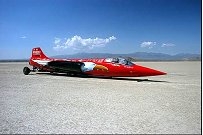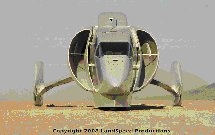by Andy Green
It’s an extraordinary time for the World Land Speed record, with a number of teams aiming to run the world’s fastest car in the next few years. This level of record-breaking activity is very rare – it happened in the 1930s, and again in the1960s, but since then it has been very quiet. Suddenly, we’re entering another ‘golden age’ for the World Land Speed Record.
Between Thrust 2 and Thrust SSC, Britain has held the Record for just over 30 years and there’s nothing quite like the promise of losing it – or actually losing it – to keep us focused on getting the record back. Great Britain has held the World Land Speed Record for longer than every other country put together, since the first record was set in 1898, and we’re not going to let it go without a fight!
However, the importance of having challengers is much wider than just a nationalistic one. We are setting off on an ‘Engineering Adventure’, to inspire and excite a generation of young people about science and technology, and the competition will make the ‘Adventure’ so much more exciting. BLOODHOUND is our solution to the problem of the ultimate race car, but it’s not the only solution. The wonderful and unique thing about this sport is that there really are no constraints on car design – a very far cry from the over-regulated and over-argumentative world of Formula 1, where all the best technology is kept secret, design is constrained by the rules, and they have to paint the cars different colours so that we can tell them apart.... For BLOODHOUND, the more competition that we have, the bigger the variety of different solutions that we can discuss in our education programme.
So who is out there at the moment? There are a number of cars that we know about, but of course we did 20 months of work in complete secrecy, so there may be others. All we can say is that we have at least a great range of competitors – and that’s a really good thing.
The North American Eagle
 The longest-running team is the North American Eagle, which is taking a novel approach to building a land speed record car: they have started with an old military jet fighter, cut the wings off and added high-speed wheels. The slightly spooky thing about their choice of donor aircraft, an ex-NASA F-104 Starfighter, is that it had the tail number 763 – the current record speed. I’m not superstitious, but that’s quite a coincidence! In overall project terms, the NAE team has tried to minimise their financial and organisational risk by avoiding the need to build a car from scratch. The trade-off in this approach is that they have inherited the engineering risk of trying to convert a vehicle that was not designed to run along the ground (it’s not really as simple as just cutting the wings off and adding wheels). The team has fitted 3 sets of wheels, with a centre set added to take the bending loads out of the fuselage, and they are still assessing the F-104’s aerodynamics on the ground. However, any big changes to the aerodynamics of their existing Starfighter fuselage will be a major challenge for the team. You have to admire the low-budget, keep-it-simple approach of the NAE – let’s hope that they manage to solve the technical problems of adapting the aircraft for supersonic ground use.
The longest-running team is the North American Eagle, which is taking a novel approach to building a land speed record car: they have started with an old military jet fighter, cut the wings off and added high-speed wheels. The slightly spooky thing about their choice of donor aircraft, an ex-NASA F-104 Starfighter, is that it had the tail number 763 – the current record speed. I’m not superstitious, but that’s quite a coincidence! In overall project terms, the NAE team has tried to minimise their financial and organisational risk by avoiding the need to build a car from scratch. The trade-off in this approach is that they have inherited the engineering risk of trying to convert a vehicle that was not designed to run along the ground (it’s not really as simple as just cutting the wings off and adding wheels). The team has fitted 3 sets of wheels, with a centre set added to take the bending loads out of the fuselage, and they are still assessing the F-104’s aerodynamics on the ground. However, any big changes to the aerodynamics of their existing Starfighter fuselage will be a major challenge for the team. You have to admire the low-budget, keep-it-simple approach of the NAE – let’s hope that they manage to solve the technical problems of adapting the aircraft for supersonic ground use.
The Eagle team has been working away for over 10 years now and has already had some success. The car has run at the Black Rock Desert (where it was limited both by the poor surface and poor weather), El Mirage, where the limiting factor was the short length of the track, and most recently at the Alvord Desert in Oregon, where they achieved around 450 mph. Clearly they’re forging ahead with an attempt on Thrust SSC’s record as soon as they can, and good luck to them. Visit www.landspeed.com for more information.
Fossett LSR
 Steve Fossett, the American Adventurer who went missing in 2007 in a light aircraft (the aircraft wreckage was discovered a year later), was in the final stages of preparing for an assault on the World Land Speed Record when he disappeared. He had bought Craig Breedlove’s old ‘Sonic Arrow’ car, which ran against Thrust SSC in 1997, and had the car rebuilt to improve both its speed and safety. The car is up for sale (and there are rumours of a buyer) so we are very much hoping to see the car run again soon.
Steve Fossett, the American Adventurer who went missing in 2007 in a light aircraft (the aircraft wreckage was discovered a year later), was in the final stages of preparing for an assault on the World Land Speed Record when he disappeared. He had bought Craig Breedlove’s old ‘Sonic Arrow’ car, which ran against Thrust SSC in 1997, and had the car rebuilt to improve both its speed and safety. The car is up for sale (and there are rumours of a buyer) so we are very much hoping to see the car run again soon.
The Fossett LSR car has used Breedlove’s old chassis and engine (both refurbished), but virtually everything else has changed. Suspension, steering, wheel base and track, systems, brake parachutes, wheels – all have been greatly modified or entirely replaced. The car retains the sleek and business-like shape of its former life and still looks fast even when it’s sitting still. This car is close to being ready to go and could easily get to a new record before we do. Let’s hope it does – it will make our ‘Adventure’ that much more exciting.
Aussie Invader 5R
Rosco McGlashan is a great character who has been pursuing the LSR for many years. His Aussie Invader 2, which was based on Richard Noble’s single-jet-engined Thrust 2 concept, was badly damaged in 1994 when it hit a timing light at over 500 mph. Rosco greatly improved the design in his next car, the Aussie Invader 3, but after weather delays in 1996/7 Rosco’s task had become hopeless – the 633 mph record that the AI3 was designed to break had now become 763 – the car was not that fast. Time to give up? Not for Rosco – time for a new car!
The Aussie Invader 5R is a rocket car that is intended to push the record way beyond Thrust SSC’s just-supersonic mark: like the BLOODHOUND Project, Rosco is aiming for 1000 mph, and he is well on with building the chassis of this near-10 tonne car (a similar weight to Thrust SSC). This is the heaviest of the cars out there and means that Rosco will need a longer track to run it – he is still searching for the ideal record location. The -5R will be fully rocket powered (rather than the more controllable, but more complicated, jet-and-rocket solution for BLOODHOUND SSC). It is the very high power available from the rocket engine that gives Rosco the confidence to aim for 1000 mph. Just as BLOODHOUND and the North American Eagle are doing, Rosco is using computational fluid dynamics (computer modelling) to analyse the airflow around his car, in order to make sure that it will stay on the ground as it goes supersonic.
Let’s hope that Rosco can find some sponsors to back this great Australian bid. There’s never been an Aussie holding the title of ‘Fastest Man On Earth’ and Rosco could be the first – go for it, cobber. Visit www.aussieinvader.com for more information
Other Cars
There are a few other teams promising to try for a new World Land Speed Record. We have very little up-to-date information on these projects, so we’re not really sure how they are getting on.
The Sonic Wind LSRV is an idea by Waldo Stakes, who has collected a lot of ex-NASA components with the intention of building a rocket car in the US.
‘The Bullet Project’ is an Australian plan to build a rocket-powered car to aim for 1000 mph. They are also hoping to start up an education programme around the technology of their car, as BLOODHOUND has done so successfully, and we wish them luck with that.
Finally, Craig Breedlove, 5 times World Land Speed Record holder, has announced that he is leading a new US record attempt. This car is based on twin jet engines and is hoping to break the current Land Speed Record. Given Breedlove’s remarkable history, anything is possible.
Maybe there are others out there as well? I hope so. It all makes our ‘Engineering Adventure’ that much more exciting!

